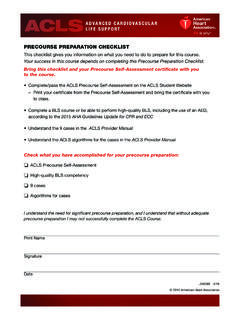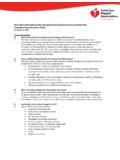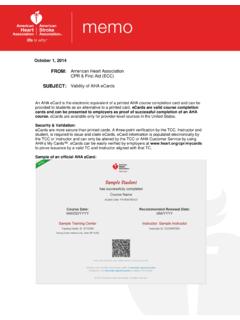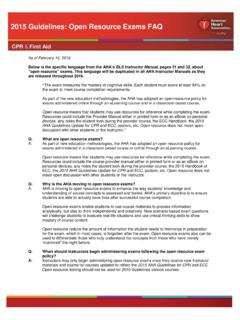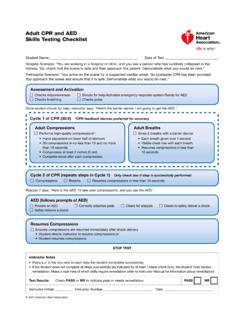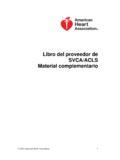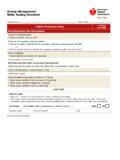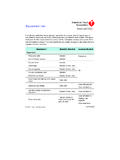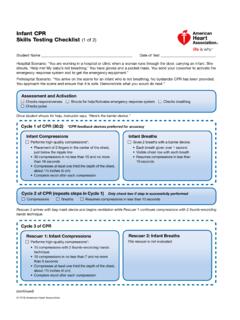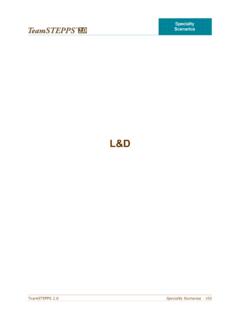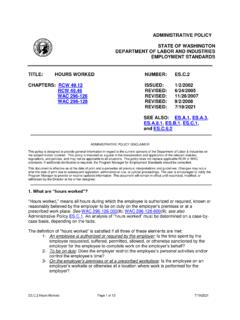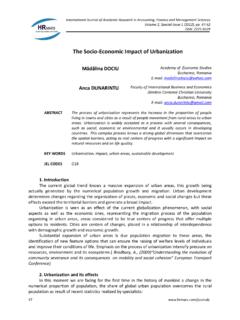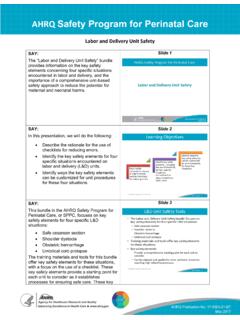Transcription of PALS Testing Case Scenarios - American Heart Association
1 2020 American Heart Association1 Testing Case Scenario 1 Hypovolemic Shock(Child)Scenario Lead-inPrehospital: You have been dispatched to transport a 5 year old with a 3-day history of fever and diarrhea. She has been increasingly lethargic in the last 2 : You are asked to assess and manage a 5 year old with a 3-day history of fever and diarrhea. She has been increasingly lethargic in the last 2 hours. Efforts for a peripheral intravenous access have been inpatient unit: You are called to assess a 5 year old who has been admitted to the ward with a 3-day history of fever and diarrhea. She has been increasingly lethargic in the last hour and has had severe ongoing diarrhea. Her intravenous access is no longer : You are called to the bedside of a 5 year old who has been admitted to the intensive care unit with a 3-day history of fever and diarrhea.
2 She has been increasingly lethargic in the last 2 hours and has had severe ongoing diarrhea. Her intravenous access is no longer SignsHeart rate 140/minBlood pressure 86/52 mm HgRespiratory rate 36/minSpo2 97% on room airTemperature C ( F)Weight 21 kgAge 5 yearsScenario overview and learning objectivesScenario OverviewEmphasis in this scenario should be on identification of compensated hypovolemic shock. Priorities include oxygen, immediate establishment of intravenous (IV) access, and administration of fluid bolus of isotonic crystalloid, repeated as needed to treat shock signs. Reassessment of cardiorespiratory status is needed during and after each fluid bolus. Glucose concentration should be checked early in this lethargic Objectives Recognizes signs of compensated and hypotensive shock; this case illustrates compensated hypovolemic shock (key indicators include anxiety, tachypnea without abnormal labor , tachycardia, cool and mottled skin, delayed capillary refill, and normotension) Summarizes signs and symptoms of hypovolemic shock; in this scenario, the child has a 3-day history of diarrhea and fever, signs of shock, and poor skin turgor Demonstrates correct interventions for hypovolemic shock.
3 The most important interventions in this scenario include oxygen administration, administration of one or more boluses of isotonic crystalloid, and careful reassessment during and after each fluid bolus Summarizes how to evaluate systemic (end-organ) perfusion; indirect indicators of end-organ perfusion include skin temperature/color, level of consciousness, and urine outputEvaluate initial assessment (Pediatric Assessment Triangle)Appearance Anxious, restlessBreathing Fast rate, increased respiratory effortCirculation Pale, dry, and significant mottling, especially in hands and feetIdentify Immediate intervention neededIntervene Activate the emergency response system. Emergency medical services requests additional assistance if needed. Administer 100% oxygen by nonrebreathing face mask.
4 Apply cardiac monitor. Apply pulse primary assessment (Focused on assessment needed to support airway, oxygenation, ventilation, and perfusion) Airway: Patent; no audible abnormal airway sounds (no stridor, no audible wheezing) Breathing/Ventilation: Respiratory rate about 36/min; minimal intercostal retractions; Spo2 97% on room air, increases to 100% with 100% oxygen; lungs clear on auscultation Circulation/Perfusion: Central pulses fair, peripheral pulses weak; Heart rate 140/min; blood pressure 100/80 mm Hg; capillary refill about 4 seconds; cool, mottled hands and feet Remainder of primary assessment performed if airway, ventilation, and perfusion are adequately supported Disability: Poor skin turgor Exposure: Temperature C ( F); weight 21 kg2 Identify Compensated shock Sinus tachycardiaIntervene Obtain vascular access (child has compensated shock, so initial attempt should focus on IV access).
5 Administer a fluid bolus of 20 mL/kg of isotonic crystalloid rapidly via IV. Assess perfusion and monitor cardiorespiratory status closely during and immediately after each fluid bolus. Stop fluid bolus if signs of Heart failure develop (eg, increased respiratory distress or development of rales or hepatomegaly). Check point-of-care (POC) glucose concentration and treat hypoglycemia, if needed. Assess response to oxygen secondary assessment (Identify reversible causes, but defer remainder of secondary assessment until after initial shock therapy)SAMPLE history (only to extent needed to evaluate reversible causes) Signs and symptoms: Diarrhea for 3 days Allergies: None known Medications: Methylphenidate Past medical history: Attention-deficit/hyperactivity disorder Last meal: No oral intake for 24 hours Events (onset): 3-day history of low-grade fever and diarrhea; noted to be increasingly lethargic in last 2 hoursPhysical examination Repeat vital signs after oxygen and one bolus of 20 mL/kg fluids: Heart rate 94/min; respiratory rate 30/min; Spo2 98% with 100% oxygen by nonrebreathing face mask.
6 Blood pressure 90/50 mm Hg Head, eyes, ears, nose, and throat/neck: Mucous membranes dry; neck supple Heart and lungs: Normal rate, no extra Heart sounds or murmurs; lungs sound clear; capillary refill down to 3-4 seconds Abdomen: No palpable liver edge; nondistended; nontender; diminished bowel sounds Extremities: Cool hands and feet; weak peripheral pulses; capillary refill 3-4 seconds, central pulses stronger Back: Normal Neurologic: Lethargic; pupils 4 mm, equal, reactiveIdentify Compensated hypovolemic shockIntervene Repeat bolus of 20 mL/kg of isotonic crystalloid IV/intraosseous (IO) push; repeat if needed to treat persistent shock symptoms. Perform careful and frequent cardiorespiratory assessment during and after each fluid bolus. Stop fluid bolus if signs of Heart failure develop (increased respiratory distress or development of rales or hepatomegaly).
7 Arrange for transfer to the intensive care unit (ICU) (unless child is already in the ICU).Evaluate diagnostic assessments (Perform throughout the evaluation of the patient as appropriate)Lab data Arterial blood gas: pH , Pco2 24 mm Hg, HCO3 13 mEq/L, PO2 74 mm Hg Glucose (POC Testing ) 70 mg/dL ( mmol/L) Pending: Electrolytes, blood urea nitrogen/creatinine, serum urea, bicarbonate level, serum lactate Cultures: Blood, urine Temperature: C ( F)Imaging Chest x-ray: Small Heart , clear lung fieldsIdentify/intervene A blood glucose concentration should be checked as soon as reasonably possible in all critically ill children, particularly neonates and infants. Hypoglycemia should be treated immediately. Metabolic acidosis should correct with effective treatment of evaluate-identify-intervene after each Assesses ABCDE, including Vital Signs Administers 100% oxygen Applies cardiac monitor and pulse oximeter Recognizes signs and symptoms of hypovolemic shock Categorizes shock as compensated Directs establishment of IV or IO access Directs rapid administration of fluid bolus of isotonic crystalloid; monitors for signs of Heart failure during and after fluid bolus Reassesses patient during and in response to interventions, particularly during and after each fluid bolus Repeats fluid bolus as needed to treat shock Checks glucose with point-of-care testingGatherStudent Observations Can you describe the events from your perspective?
8 How well do you think your treatments worked? Can you review the events of the scenario (directed to the Timer/Recorder)? What could you have improved? What did the team do well?Instructor Observations I noticed that [insert action here]. I observed that [insert action here]. I saw that [insert action here].AnalyzeDone Well How were you able to [insert action here]? Why do you think you were able to [insert action here]? Tell me a little more about how you [insert action here].Needs Improvement Why do you think [insert action here] occurred? How do you think [insert action here] could have been improved? What was your thinking while [insert action here]? What prevented you from [insert action here]?SummarizeStudent-Led Summary What are the main things you learned? Can someone summarize the key points made?
9 What are the main take-home messages?Instructor-Led Summary Let s summarize what we Here is what I think we The main take-home messages What are the therapeutic end points during shock management? (Answer: Normalized Heart rate; improved peripheral perfusion, mental status, and urine output; normalized blood pressure; correction of metabolic/lactic acidosis) Which are the indirect signs of improved end-organ function? (Answer: Improved skin blood flow, increased responsiveness/improved level of consciousness, increased urine output, correction of lactic acidosis)Debriefing ToolTesting Case Scenario 1, Hypovolemic Shock (Child)General debriefing principles Use the table that follows to guide your debriefing; also refer to the Team Dynamics Debriefing Tool. Debriefings are 10 minutes long.
10 Address all learning objectives. Summarize take-home messages at the end of the debriefing. Encourage students to self-reflect, and engage all participants. Avoid mini-lectures, closed-ended questions, and dominating the management objectives Uses the pals Systematic Approach Algorithm to assess and appropriately classify a patient Provides oxygen appropriately Directs delivery of high-quality CPR (including the use of a feedback device) when indicated Demonstrates basic airway maneuvers and use of relevant airway device as appropriate Demonstrates application of cardiac and respiratory monitors Identifies the cardiac rhythm Applies appropriate PBLS or pals algorithms Summarizes general indications, contraindications, and doses of relevant drugs Discusses principles of family-centered care in pediatric cardiac arrest Applies the 8 elements of effective team dynamics Performs frequent reassessment4 2020 American Heart Association5 Scenario overview and learning objectivesScenario OverviewEmphasis in this scenario is on rapid identification and management of respiratory distress/potential respiratory failure caused by lower airway obstruction/asthma.
